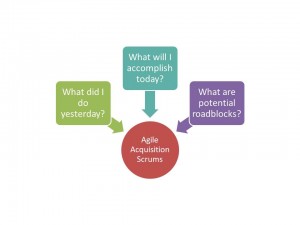 A new trend in acquisition – applying the modular method of “Agile” software development using daily meetings and lessons learned – is more productive than acquisition support done the “old way” because it utilizes necessary resources when and where they are required. Agile methodology applied to acquisition support is an increasingly preferred technique among Government agencies, that has brought valuable output, effectiveness, accountability and traceability to the acquisition process.
A new trend in acquisition – applying the modular method of “Agile” software development using daily meetings and lessons learned – is more productive than acquisition support done the “old way” because it utilizes necessary resources when and where they are required. Agile methodology applied to acquisition support is an increasingly preferred technique among Government agencies, that has brought valuable output, effectiveness, accountability and traceability to the acquisition process.
In a previous Agile Acquisition blog post, I outlined the basic components, participants and functions of the Agile framework (in Part I – The Basics). In Part II, I will go into more depth by outlining the benefits that can result from this particular methodology in acquisition support processes.
Collaboration with Participants and Stakeholders
In a traditional non-Agile acquisition framework, team members usually only work with a couple of points of contact (for example, only the contracting activity). Knowledge sharing in this context is limited due to the lack of diversity, and those who need procurement package information may not receive it until much later (and sometimes too late). This causes progress delays.
The Acquisition Support Team (AST) is able to overcome this inefficiency in an Agile framework by acquiring ample information and data for all key players, due to close collaboration with all participants, stakeholders, teammates and management personnel. This not only ensures quick and accurate answers for all uncertainties, but also helps identify current and potential obstacles, promoting risk identification and mitigation through discussions of ways to resolve or prevent such obstacles.
One Primary POC in “Cradle-to-Grave”
Without Agile methodology, knowledge is unlikely to be properly transferred during each stage of the acquisition life cycle. Alternatively, Agile Acquisition support ensures one AST as the primary point of contact for contract actions. This aligns staff with a single program area, COR or contracting office, which has three primary benefits:
- Avoiding the time-consuming necessity of re-explaining the history of a requirement or contract, which saves the Government valuable time
- Preventing the loss of important information, documents or files due to errors that can occur while transferring knowledge and/or documents
- Encouraging assigned staff to know and understand their “accounts” fully, as primary and secondary points of contact
Daily Scrum Reports
The daily scrum meetings allow management to be fully aware of updates on daily activities and the actions of every team member. During these meetings, team members share lessons learned, provide feedback for speedy corrections of processes where necessary, and predict potential obstacles. This open discussion not only promotes efficiencies and future productivity through the sharing of lessons learned, but also avoids duplication of effort and over-working any one team member because management is fully engaged regarding everyone’s workload and activities. Therefore, scrums also help with effective planning of assignments for a fair distribution of team member responsibilities.
The daily input and updates each team member must provide at scrums promotes full accountability and traceability of each team members’ activities, due to their obligation to continually track their progress and keep management aware of their contributions. This also helps team members be ready at all times to discuss their work and articulate their progress with the client whenever necessary.
Client Contact
Scrums prepare both team members and managers to communicate specifically and openly with the customer about the status and accomplishments of a project. The Agile methodology encourages management to better inform and engage the client through regular meetings to demonstrate the added value of the team and keep clients up-to-date on project status.
Second-Eye Review
The second-eye review process allows a fresh set of eyes to examine documents from the client’s point of view, helping the team identify and correct inaccuracies or areas of clarification before submitting it to the customer. At the large scrum meetings, team members are able to share all edited versions of a document to ensure all members are aware of the progress and of who holds the “master” version.
Agile and the Future
From streamlined processes and diligent status reporting, to constructive information-gathering and enhanced contact with the client, numerous benefits make Agile methodology the ideal choice for enhancing both the quality and efficiency of acquisition support in the Federal Government today. In fact, the GAO’s July 2012 report, “Effective Practices and Federal Challenges in Applying Agile Methods,” recommended that Agile practices be highlighted as part of the government’s overall effort to promote modular development.
The industry in future years is likely to see an increase in the use of Agile methodology not only in IT development, but also applied to acquisition support. The favorability of this technique largely stems from its facilitation of frequent and transparent communication, which reduces risk by providing feedback early and often. Overall, Agile methodology provides the platform for ensuring issues are identified and resolved quickly, before more investment dollars are unnecessarily spent.
Related Article: Agile Acquisition Support – Real-World Considerations



